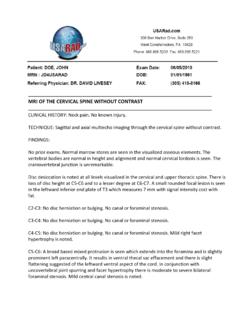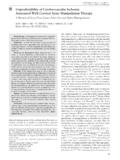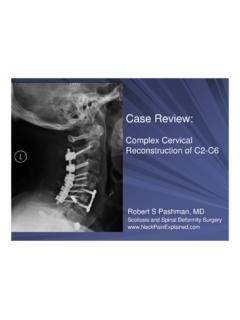Transcription of Occipital Cervical Fusion System TG - Testimonials
1 Occipital Cervical Fusion System . Implants and instruments designed to optimize fixation to the occiput. Technique Guide Instruments and implants approved by the AO Foundation Table of Contents Introduction Occipital Cervical Fusion System 2. AO Principles 4. Indications 5. Surgical Technique Preparation 6. Occipital Plate Technique 8. Occipital Clamp Technique 19. Occipital Plate/Rod Technique 28. Implant Removal 34. Product Information Implants 35. Instruments 36. Set List 39. Image intensi er control Synthes Spine Occipital Cervical Fusion System The Synthes Occipital Cervical Fusion System is intended to Instruments provide stabilization as an adjunct to Fusion of the occipito- Slender design maximizes visualization Cervical junction.
2 The OC Fusion System includes a complete Universal joint and flexible instruments set of implants and instruments designed to optimize fixation Accommodate minimal exposures to the occiput and easily connect with Synthes Cervical and Adapt to varying patient anatomy thoracic systems. Depth control on drills and taps Features The OC Fusion System offers the surgeon several implant options to maximize fixation to the occiput and minimize the implant footprint. The instrumentation is designed to accom- modate minimal exposures and varying patient anatomy. Midline plate construct Lateral wedge plate construct 2 Synthes Spine Occipital Cervical Fusion System Technique Guide One-hole clamp construct Two-hole clamp construct Plate/rod construct Synthes Spine 3.
3 AO Principles In 1958, the AO formulated four basic principles, which have become the guidelines for internal They are: Anatomic reduction Stable internal fixation Preservation of blood supply Early, active mobilization The fundamental aims of fracture treatment in the limbs and Fusion of the spine are the same. A specific goal in the spine is returning as much function as possible to the injured neural AO Principles as Applied to the Spine3. Anatomic alignment In the spine, this means reestablishing and maintaining the natural curvature and the protective function of the spine.
4 By regaining this natural anatomy, the biomechanics of the spine can be improved, and a reduction of pain can be experienced. Stable internal fixation In the spine, the goal of internal fixation is to maintain not only the integrity of a mobile segment, but also to maintain the balance and the physiologic three-dimensional form of the A stable spinal segment allows bony Fusion at the junction of the lamina and pedicle. Preservation of blood supply The proper atraumatic technique enables minimal retraction or disturbance of the nerve roots and dura, and maintains the stability of the facet joints.
5 The ideal surgical technique and implant design minimize damage to anatomical structures, facet capsules and soft tissue attachments remain intact, and create a physiological environment that facilitates healing. Early, active mobilization The ability to restore normal spinal anatomy may permit the immediate reduction of pain, resulting in a more active, functional patient. The reduction in pain and improved function can result when a stable spine is achieved. 1. M ller, M. Allg wer, R. Schneider, and H. Willenegger: Manual of Internal Fixation, 3rd Edition. Berlin: Springer-Verlag.
6 1991. 2. Ibid. 3. M. Aebi, Thalgott, and Webb. AO ASIF Principles in Spine Surgery. Berlin: Springer-Verlag. 1998. 4 Synthes Spine Occipital Cervical Fusion System Technique Guide Indications The OC Fusion System is intended to provide stabilization as an adjunct to Fusion of the Occipital - Cervical junction. A com- plete Occipital - Cervical -thoracic construct can be created by hooks (C1 T3) and screws (T1 T3) that have been previously cleared within the CerviFix System , Axon System , and Synapse System . The OC Fusion System is indicated for skeletally mature pa- tients using allograft and/or autograft for the following indications: DDD of the Cervical vertebrae (defined as neck pain of discogenic origin with degeneration of the disc as confirmed by patient history and radiographic studies).
7 Spondylolisthesis Spinal stenosis Fracture/dislocation Atlanto/axial fracture with instability Occipital - Cervical dislocation Revision of previous Cervical spine surgery Tumors The use of screws is limited to placement in the occiput. Screws are not intended to be placed into the Cervical spine. Warning: These devices are not indicated for screw attach- ment or fixation to the posterior elements (pedicles) of the Cervical , thoracic (T4-T12), or lumbar spine. Please refer to package insert for the full list of indications, contraindications, warnings and/or precautions. Synthes Spine 5.
8 Preparation 1. Preparation Required sets Occipital Cervical Fusion Instrument and Titanium Implant Set Synapse Instrument and Titanium Implant Set or Synapse mm Rod Instrument and Titanium Implant Set Optional sets Titanium Axon Auxiliary Screw Set StarLock Instrument and Titanium Implant Set CerviFix Titanium Hook, Rod, and Connector Module Set Axon Instrument and Titanium Implant Set CerviFix Titanium Clamp and Screw Module Set CerviFix Instrument Set 6 Synthes Spine Occipital Cervical Fusion System Technique Guide 2. Preoperative planning All necessary imaging studies should be available to plan Occipital screw placement and accommodate varying patient anatomy.
9 3. Position patient Patient positioning is critical for occipitocervical Fusion procedures. The patient should be placed on the operating table in the prone position with the patient's head securely immobilized. Confirm proper patient position by direct visualization before draping, and by radiograph. Always use caution when positioning the patient, as physiological alignment may not be attainable. 4. Approach Make a standard midline incision from the external Occipital protuberance and continue caudally, to appropriately expose the Cervical /thoracic levels to be surgically treated.
10 Synthes Spine 7. Occipital Plate Technique 1. Attach bone anchors Attach bone anchors to the Cervical and thoracic spine, as described in the Synapse, Axon and StarLock technique guides. Note: Titanium hooks are indicated for use in the Cervical and upper thoracic spine (C1 T3). Screws are indicated for use in the upper thoracic spine (T1 T3). 2. Select Occipital plate Instruments Template, for Occipital Plate Plate Holder Select a template of the plate style and size estimated to best fit the occiput, as determined by the separation of the rods. Contour the template to fit the anatomy.







